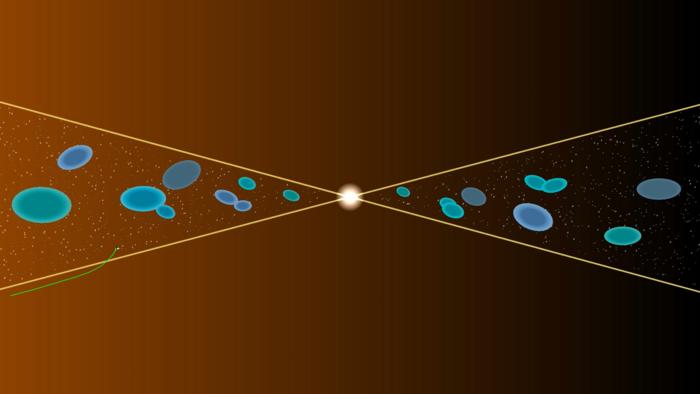In a groundbreaking advancement in solar physics, researchers led by the Southwest Research Institute (SwRI) have unveiled compelling evidence identifying magnetic reconnection near the Sun as a powerful accelerator of charged particles, notably protons, energizing them to extreme levels. These observations were captured by NASA’s Parker Solar Probe during its unprecedented proximity to the Sun, marking a significant stride in understanding particle acceleration mechanisms within the heliosphere’s dynamic environment.
The Parker Solar Probe, engineered to conduct in situ measurements within the solar corona, repeatedly traverses the Sun’s outer atmosphere, venturing closer than any spacecraft previously dared. During one such pass, the probe intersected the heliospheric current sheet (HCS), a vast surface where the Sun’s magnetic field polarity reverses sharply. At this boundary layer, scientists observed merging magnetic islands and jets of plasma, signatures indicating active magnetic reconnection processes. These reconnection events precipitated the acceleration of protons sunward to energies approaching 400 keV, an observation that decisively links particle energization to magnetic reconnection mechanisms in the near-Sun environment.
Magnetic reconnection is a fundamental plasma physics process whereby magnetic field lines of opposing polarity converge, sever, and reconnect in a violent, rearranging event that liberates significant amounts of magnetic energy. This energy conversion spawns high-speed plasma flows and accelerates charged particles to supra-thermal energies. While extensively studied in Earth’s magnetosphere and distant astrophysical environments, witnessing this process near the Sun with direct particle measurements provides a new vantage point on the mechanisms that govern solar wind energization and transient explosive phenomena like solar flares and coronal mass ejections.
The SwRI-led team’s findings hinge on Parker Solar Probe’s detection of a reconnection exhaust within the HCS, wherein the spacecraft recorded trapped populations of energetic protons with energies remarkably exceeding the local magnetic energy per particle by factors of a thousand. Such extreme energy densities affirm that magnetic reconnection is not merely a theoretical construct but a tangible source of these energetic particles. Crucially, analysis differentiated these protons from solar flare-derived particles, confirming their unique origin at HCS reconnection sites, a nuance that solves longstanding ambiguities regarding particle source regions near the Sun.
Delving into the physics, the reconnection process at the HCS involves fragmented magnetic islands—plasmoids—that coalesce and evolve rapidly, creating localized acceleration sites. Electrons and ions become trapped within these magnetic structures, gaining energy through complex interactions with reconfiguring magnetic fields and induced electric fields. This dynamic environment fosters particle energization that can explain observations of high-energy particle populations detected by spacecraft, linking macroscopic magnetic topology changes with microscopic particle kinetics.
Understanding these reconnection events carries profound implications for space weather forecasting and predictive capabilities. Energetic particles originating near the Sun can propagate toward Earth, influencing geomagnetic environments, satellite operations, and terrestrial technologies. The May 2024 geomagnetic storms, which disrupted GPS-guided agricultural equipment causing substantial economic losses, underscore the urgent need to comprehend solar energetic particle sources. The Parker Solar Probe’s novel data offer a pathway to refine models of particle acceleration and propagation, offering potential forecasting improvements for solar storm impacts.
Moreover, the insights gleaned illuminate the persistent enigma of coronal heating—the process responsible for elevating the solar atmosphere to temperatures far exceeding the solar surface. Magnetic reconnection at the heliospheric current sheet emerges as a viable contributor to this heating, generating localized energy release that feeds into the solar wind acceleration mechanisms. By quantifying energy transformations in these near-Sun regions, scientists move closer to reconciling theoretical models with observed solar atmospheric conditions.
The Parker Solar Probe’s unique instrumentation suite permitted detailed characterization of magnetic fields, plasma velocities, and particle energy spectra during its HCS crossings. These comprehensive measurements enabled disentangling competing particle acceleration processes and isolated magnetic reconnection as the prime driver of the energetic proton populations. Such observational breakthroughs underscore the pivotal role of spacecraft missions probing hostile solar environs, where direct measurements are critical to advancing heliophysics.
From a broader astrophysical perspective, the phenomena observed near the Sun offer parallels to magnetic reconnection processes in other cosmic plasmas, including planetary magnetospheres, astrophysical jets, and accretion disks. The mechanisms elucidated in the solar corona serve as natural laboratories for plasma physics, where in situ data validate and challenge theoretical frameworks that extend well beyond our solar system. These cross-disciplinary connections enrich both solar and astrophysical sciences.
Additionally, the understanding of magnetic reconnection holds significance for controlled nuclear fusion research on Earth. Reconnection drives plasma instabilities and energy release within fusion devices, impacting the attainment of sustained fusion conditions. Insights from near-Sun reconnection events thus inform laboratory plasma confinement strategies, providing analogies and guiding principles to mitigate detrimental reconnection-induced disruptions in fusion reactors.
NASA’s Living With a Star program underpins the Parker Solar Probe mission, emphasizing the strategic importance of studying Sun-Earth interactions that directly affect human society. Operated by the Johns Hopkins University Applied Physics Laboratory, the spacecraft continually expands human knowledge of solar-terrestrial coupling and space weather dynamics through its daring excursions into the corona. The recent discoveries from HCS reconnection add a critical chapter to this unfolding exploration narrative.
In conclusion, the SwRI-led study reveals magnetic reconnection at the heliospheric current sheet near the Sun as a potent accelerant of charged particles, fundamentally advancing our grasp of solar plasma dynamics and particle energization. These findings not only elucidate central processes governing solar wind formation and space weather but also create pathways for deeper inquiry into plasma physics, astrophysics, and applied fusion research. As Parker Solar Probe continues its missions, we anticipate further revelations that will reshape our understanding of the Sun’s influence on the solar system and Earth’s technological infrastructure.
Subject of Research: Not applicable
Article Title: Magnetic Reconnection-driven Energization of Protons up to ~400 keV at the Near-Sun Heliospheric Current Sheet
News Publication Date: June 3, 2025
Web References:
https://youtu.be/GusNQPDgGZY
https://www.swri.org/markets/earth-space/space-research-technology/space-science/heliophysics?utm_campaign=magnetic-reconnection-pr&utm_source=eurekalert!&utm_medium=referral
References:
DOI: 10.3847/2041-8213/ada697
Image Credits: JHUAPL
Keywords
Solar physics, Solar wind, Space weather, Heliosphere




